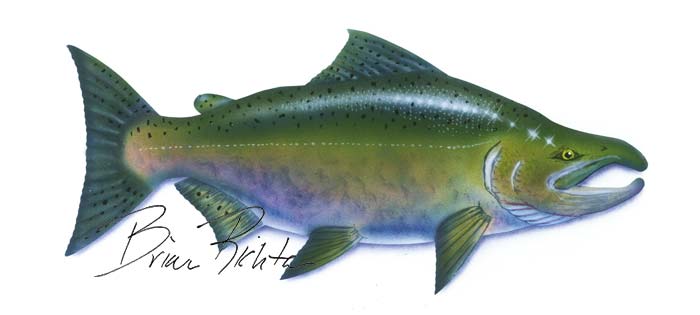A native type of rainbow trout, Steelhead are anadromous; the are born and rear in freshwater, then spend the rest of their lives in the ocean before returning to spawn. Steelhead change from chrome silver to a deep red when spawning. Entering low in river drainages during the fall, steelhead spend the winter in river pools, waiting to spawn in the spring. They are a strong fish that fights well. Found locally in the Clearwater, Snake and Salmon River.
Brian Richter

Identify your Fish

All of our species images were done by guide Brian Richter. It is his passion for fishing and the local area, along with his love for art that makes these images so unique. Confident in a number of mediums, he chose acrylic airbrush for these fish, giving them a vibrant and life-like feel. We are proud to have such a talented staff member!
Bull Trout
A member of the char family, the bull trout is a close relative to brook trout and the coastal Dolly Varden. Identifiable by their dark green back and sides, dotted with pink spots and white edged pectoral, anal and pelvic fins. A closer look will reveal translucent fins, a trait distinguishing them from brook trout. An Idaho native, they are found throughout the state’s mountain rivers, lakes and creeks. Bull trout are protected under the Endangered Species Act and it is illegal to harvest them in Idaho. Found locally in the Salmon River and the Headwaters of the Middle Fork.
Mountain White Fish
The mountain whitefish is a true native to Idaho and most of the west. They are a strong indicator of stream health and are essential to local ecosystems. Almost clear in appearance when they are young, these fish mature into a gray/blue or tan/pink color, have large scales and no teeth. Known for feeding mostly subsurface, they typically eat bottom-dwelling aquatic insects, but have been known to eat terrestrial insects on the surface during prolific summer hatches. Found locally in the Big Wood, Big Lost, Copper Basin, Salmon River and the Headwaters of the Middle Fork.
Chinook Salmon
Native to Idaho, Chinook salmon, also known as “Kings” are the largest and most athletic of all Pacific salmon. By the time they have returned to our waters for spawning their bodies have transformed into a deep olive. Ranging from 18-40+ inches, these fish typically spend between 1-3 years at sea. Juveniles feed on aquatic and terrestrial insects in headwater streams and rivers, while returning spawning Chinook do not eat. However, adults will strike at bright lures and flies out of aggression. Found locally in the Salmon River; the longest and highest migration of any salmon in the world.
Kokanee Salmon
A landlocked form of the sockeye salmon, Kokanee are found throughout Idaho in deep lakes and reservoirs. Known for their blue backs and silver bellies, they are a small salmon, typically between 10-14 inches long. From September through December Kokanee head upstream to spawn, turning a beautiful scarlet red. They typically feed on zooplankton and occasionally on midges and aquatic insects. In the summer months they live deep in the lakes, coming to the surface to feed sporadically. Found locally in the upper Big Lost and the South Fork of the Boise.
Snake River Fine-Spotted Cutthroat Trout
Easily identified by their bright orange streak (cut) in the folds of their jaw, cutthroats are found in lakes, rivers and streams throughout Idaho. While being native to the Snake River basin, Fine-Spotted Cutthroat were historically not found in our local waters. They have been recently introduced to the upper Big Lost and provide great angling opportunities. Snake River Fine-Spotted Cutthroat have many small spots evenly distributed over the bodies and are more pale olive/yellow in color. Found locally in the Copper Basin.
Westslope Cutthroat Trout
Easily identified by their bright orange streak (cut) in the folds of their jaw, Westslope cutthroats are found in lakes, rivers and streams throughout Idaho. Native to most Idaho waters, they have been recently introduced into high mountain lakes. Westslopes can be distinguished from other cutthroat species by large black spots that become more clustered towards their tail. Typically feeding on insects and zooplankton, cutthroat won’t shy away from larger streamer patterns. Found locally in the Salmon River and the Headwaters of the Middle Fork.
Brook Trout
Originally introduced in the early 1900’s from the eastern U.S. and Canada, brook trout are now found across the west. Belonging to the Char family, brook trout can be identified by their blue haloed red spots and their white edged pectoral, anal and pelvic fins. Feeding on just about anything that comes their way, brook trout are very aggressive, pound for pound one of the toughest fish out there. Locally brook trout can be found in Silver Creek, the Big Wood, Copper Basin, the Big Lost and the Little Wood.
Brown Trout
Native to Europe, the territorial brown trout was introduced to Idaho waters in 1892. Golden in color, they are the only trout with both red and large black spots. They are aggressive fish, feeding on a variety of small fish and invertebrates. One of the more difficult trout to catch on the fly, they are most active at dawn and dusk, feeding on mayflies, stoneflies and caddis hatches. Found locally in Silver Creek, the Little Wood and the lower Big Wood.
Rainbow Trout
Probably the most sought after trout in the west, rainbows are tireless fighters and love to go airborne. Most easily identified by their “rainbow” band, these fish also have black spots, and dark green backs. Take note of the white tips on their pectoral, anal and pelvic fins, a trait distinguishing them from local cutthroat trout. Native to many Idaho waters, they can be found in ponds, lakes, streams and rivers. Found locally in the Big Wood, Little Wood, Big Lost, Copper Basin, the Salmon River and Silver Creek.













